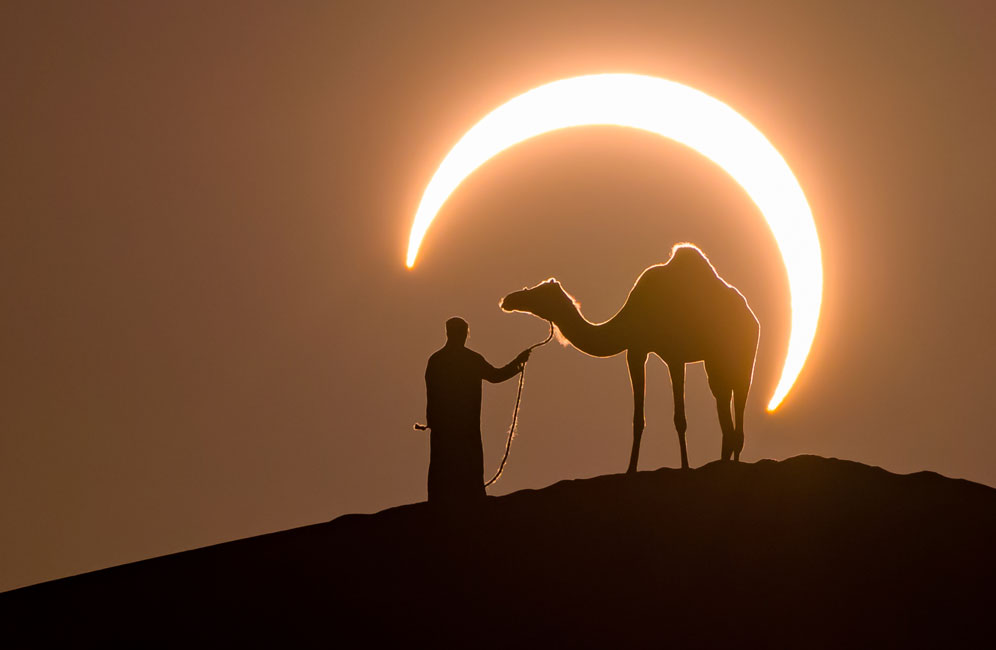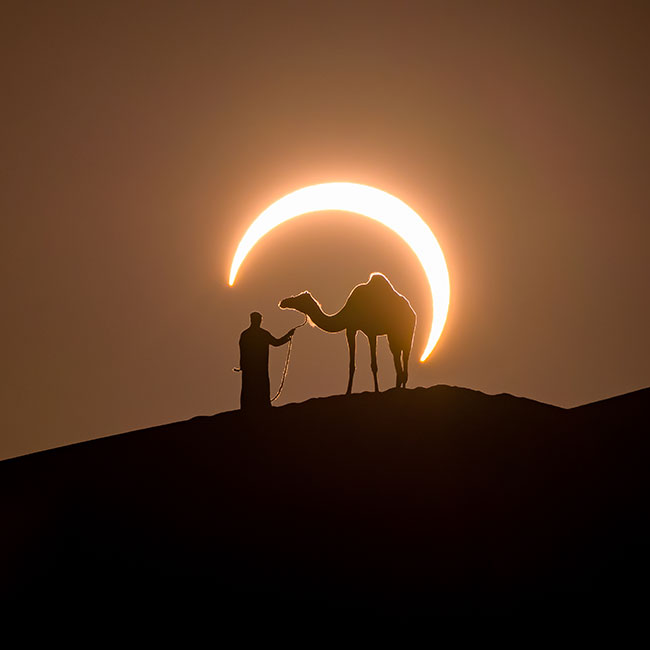Photographing an Annular Solar Eclipse in the Desert
Nikon Z 7 in DX crop mode, with the AF-S NIKKOR 200-500mm f/5.6E ED VR lens attached using the Mount Adapter FTZ. Focal length at 500mm (750mm equivalent in DX mode), f/8, 1/100 second, ISO 200, manual exposure, Matrix metering. A 10-stop ND (neutral density) filter was on the lens. Final image was cropped square on the computer.
We spoke with Joshua Cripps about an image he created during an annular solar eclipse in the Dubai desert. He was already going to be in the Middle East in mid-December 2019 and when he found out there would be an annular solar eclipse and he decided to extend his trip to photograph it.
Joshua says he spent a “crazy amount of planning” the shoot. He used the PhotoPills app to plan the location aspects of the shot including the shooting position he would be in as well as the position of the man and camel.
He says, “Ultimately [what] made my decision was the sun’s height at totality. From the UAE, the sun would only be about 6° above the horizon during totality. This meant it would be far easier to get a subject into the shot with the eclipse.”
Once he knew where he wanted to be for the eclipse, Joshua says, “The next step was determining what that subject should be. Since the path of totality swept right through the Empty Quarter, an endless expanse of sand dunes, I wanted something representative of that region and landscape. I came up with a list of possible subjects, including Arabian horses, camels, falcons, and Arabian oryxes.” He eventually settled on a camel—being a domesticated animal—as it allowed him more control along with the farmer.
Joshua says that finding a suitable spot for the camel and farmer to stand was tedious. “That process was painstaking because I had a very specific vision for how I wanted the shot to turn out: I wanted the camel and the man standing on a sand dune encircled by the eclipse.
He planned everything down to the specific GPS coordinates for where he would be standing to shoot and the spot for the subjects.
The location where the image was created was about seven kilometers from Tal Moreeb, near the Liwa Oasis in the Empty Quarter desert. Tal Moreeb is one of the highest sand dunes in the world and is found in the United Arab Emirates.
“In order to have this specific proportion between the size of the camel and the size of the sun we had to be standing a very specific distance away from the camel, almost exactly 1,000 feet,” Joshua says. “In addition to that shooting distance we also needed to find a dune that was visible against the sky at a very specific angle (6.15°) so that the sun would be in eclipse exactly when it rose behind the dune. Finding a dune that met those exact criteria was a challenge, but ultimately we succeeded,” he added.
Because Joshua only spoke English and the farmer only spoke Arabic he drew an image in the sand to show the man what he wanted him to do.
The Waiting Game
On the morning of the eclipse, once the man and camel were in position, all Joshua had to do was wait for the “show” to begin. When that happened, he said, “I started snapping like crazy!”
“During the eclipse I was running around like a madman, aligning different compositions and chasing the sun. Because the sun is in constant motion, I too had to be in constant motion to keep it aligned with the man and the camel. All in all during a 23-minute window (although totality was only 3 minutes, the full eclipse lasted much longer), I shot 133 images of the scene. So I have many, many alternate compositions.”
“The other technical challenge was the exposure. I knew I wanted the man and the camel to be in silhouette, but I also wanted rim light around their clothes and fur. So finding that balance was a constant tightrope act, and I had to continually adjust the exposure during the various eclipse phases as the scene got brighter or darker.”
“It was also important not to fry my image sensor by keeping it pointed directly at the sun without any protection. Even during an eclipse the light from the sun can easily damage your camera sensor (and eyes), especially if you're using a long telephoto lens. However, I was worried that a solar filter would block too much of the sun’s light and would prevent the silhouettes from being visible. So I started the day with a 20-stop ND filter over my lens. That too quickly proved to be too dark so I switched to a 10-stop ND. This turned out to be a perfect choice as it allowed me to maintain a reasonably fast shutter speed (so to freeze any motion by the camel) at low ISOs, and with a good exposure that balanced the brightness of the sun with the brightness of the overall scene and silhouettes.” [Editor’s note: although this worked out for Joshua, it is always recommended that you only use a solar filter over your camera’s lens and use solar eclipse viewing glasses to protect your own vision when viewing and photographing a solar eclipse. The only time it is safe to view a solar eclipse with the naked eye is when the eclipse is at the totality phase.]
“The annular eclipse is unique because while the moon and sun are in perfect alignment the moon’s apparent size is a bit smaller than the sun’s. This leads to a ‘ring of fire’ effect during totality. As opposed to a total solar eclipse where the sun and moon are basically the same size, leading to a ‘nighttime during the day’ effect. For this annular eclipse the day hardly got darker at all even though 95% of the sun was eclipsed,” Joshua explains.
Shooting photos like this is an addiction. It’s such an extreme technical and creative challenge.
Future Eclipses
He’s already thinking about the next one: “The next total solar eclipse will be on December 14, 2020, visible from a small slice of South America. So the wheels are already turning... What can I shoot during that eclipse?”
Each year, there are usually one or two solar eclipses which are followed closely by lunar eclipses—they occur in clusters—but they aren’t always visible from land.
“It’s a fantastic technical and creative challenge to create images that are only possible once or twice a year,” Joshua says.
Social Media Surprise
Joshua was surprised at the speed at which the image gained attention on social media. He says he posted the photo to Instagram and Facebook around 1 pm local time in Dubai and took an hour long nap. “When I woke up an hour later the gas had already been poured on the fire: thousands of likes and hundreds of comments. Ultimately the photo achieved an organic reach of over 2 million people on Facebook, with another 200,000 on Instagram, with about 75,000 likes between the two platforms.”
Joshua says, “The most common response I’ve been getting is from people who love seeing all the work that goes into creating a shot like this. I recorded an Instagram story during the planning and shooting process, and people have really appreciated the behind-the-scenes look into how the photo was made.”
“Shooting photos like this is an addiction. It’s such an extreme technical and creative challenge. It’s pretty stressful but when it pays off you’re rewarded with a unique image that is well and truly yours, one that is very unlikely to ever be repeated. That’s an incredibly cool feeling as a photographer, and I plan to keep shooting photos like this as often as possible.”
For anyone interested in photographing eclipses, Joshua suggests using an app like PhotoPills to help you predict behavior of the sun and moon, and practice lining up these celestial bodies with interesting things on the Earth, like mountains, buildings, trees or people. Practice a bunch and you’ll get a sense about how the sun and moon move, what kinds of focal lengths will make the best shot, and what makes for an interesting subject and composition.







